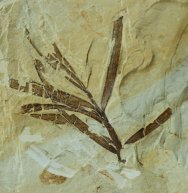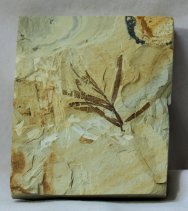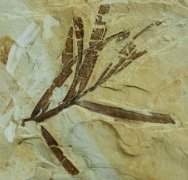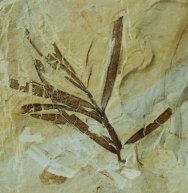Cf Lindleycladus sp
Incertae
sedis
Geologic
Time: Lower Cretaceous, Late Aptian-Cenomanian Stage (108-92 million
years ago)
Size (25.4
mm = 1 inch): Plant fossils is 45 mm by 45 mm wingspan Matrix: 95 mm
by 80 mm
Fossil Site:
Crato Formation, Nova Olinda Member, Ceara, Brazil
Fossil Code:
GF87
Price: Sold
 Description:
The Araripe Basin of Brazil is home to a fantastic array of exquisitely-detailed
Early Cretaceous fossils, some of which have been preserved in
three dimensions. While the entire formation has until the last
decade or so been termed the Santana Formation, David Martill
has separated out the slightly older insect-bearing strata as
the Nova Olinda Member of the Crato Formation. Quarrying operations
for the purposes of obtaining paving stones exposes the remarkable
insect fauna in much the same way that quarrying for lithographic
limestone in Solnhofen has afforded a panoply of wonderfully-preserved
Jurassic fossils in Germany. In addition to the many orders of
insects, spiders, scorpions, decapod crustaceans, many plants
have been found. The plants are of interest as they come from
a time which sae the rise of the angiospermsat the expense of
the gymnosperms. This one is a gymnosperm most likely Lindleycladus.
While its affinities are uncertain, it is most likely a n araucarian
conifer. This is the first example I have been able to secure
in fourteen seasons. Description:
The Araripe Basin of Brazil is home to a fantastic array of exquisitely-detailed
Early Cretaceous fossils, some of which have been preserved in
three dimensions. While the entire formation has until the last
decade or so been termed the Santana Formation, David Martill
has separated out the slightly older insect-bearing strata as
the Nova Olinda Member of the Crato Formation. Quarrying operations
for the purposes of obtaining paving stones exposes the remarkable
insect fauna in much the same way that quarrying for lithographic
limestone in Solnhofen has afforded a panoply of wonderfully-preserved
Jurassic fossils in Germany. In addition to the many orders of
insects, spiders, scorpions, decapod crustaceans, many plants
have been found. The plants are of interest as they come from
a time which sae the rise of the angiospermsat the expense of
the gymnosperms. This one is a gymnosperm most likely Lindleycladus.
While its affinities are uncertain, it is most likely a n araucarian
conifer. This is the first example I have been able to secure
in fourteen seasons.
|
|



